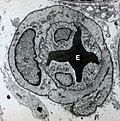Blood vessel
A blood vessel is a tube that carries blood in the circulatory system. Blood vessels that take blood away from the heart are arteries. Blood vessels that take blood back to the heart are veins. Capillaries are between veins and arteries and they supply tissue with blood.
The heart plus all of the blood vessels in the body together are called the circulatory system. Blood is moved by the pumping of the heart and carries oxygen to the tissues.
The expansion of blood vessels is called vasodilation, it helps the body to get rid of heat energy (vas- in Latin means "container" or "vessel"[1]). The constriction of blood vessels is called vasoconstriction, it prevents the body from losing warmth.
Originally, August Krogh estimated that there was 100,000 km (60,000 miles) of combined blood vessels in the human body. However, his figure was based off of incorrect assumptions assuming that the density of blood vessels in the human body was significantly more than what we know today. He based his calculations on the assumption of a 143kg body with 50kg of pure muscle, an unrealistic body, leading to unrealistic estimations. A new study[2] determined that the actual is somewhere between 9,000 km - 19,000 km (5,600 miles - 11,800 miles).
Growing new blood vessels is called angiogenesis.
Structure
Different parts of the body have different kinds of blood vessels for different parts of their work. The vessel wall consists of three shells:
- inner - represented by the endothelium (single-layer squamous epithelium), which is built of elongated endothelial cells located on the basement membrane, and the subendothelial layer, which is based on loose fibrous connective tissue;
- middle - consists of circular bundles of smooth muscle cells with layers of elastic fibers;
- external - is represented by loose fibrous connective tissue, which contains a lot of blood vessels and nerve fibers.
The structure of the vessel wall depends on hemodynamic conditions: blood flow velocity, volume and blood pressure. Arteries located close to the heart are characterized by a predominance of elastic elements that are able to counteract high hemodynamic parameters. As you move away from the heart, hemodynamic values decrease, the caliber of blood vessels decreases and the number of muscle elements in their walls increases, which are able to create additional force to push blood into the network of the smallest vessels.
Blood Vessel Media
Transmission electron micrograph of a microvessel displaying an erythrocyte (E) within its lumen which is deformed due to vasoconstriction
References
- ↑ Harper, Douglas (2001–2016). "Online Etymology Dictionary". Online Etymology Dictionary. Retrieved March 8, 2016.
- ↑ Poole, David C.; Kano, Yutaka; Koga, Shunsaku; Musch, Timothy I. (2021-03-01). "August Krogh: Muscle capillary function and oxygen delivery". Comparative Biochemistry and Physiology. Part A, Molecular & Integrative Physiology. 253 110852. doi:10.1016/j.cbpa.2020.110852. ISSN 1531-4332. PMC 7867635. PMID 33242636.

